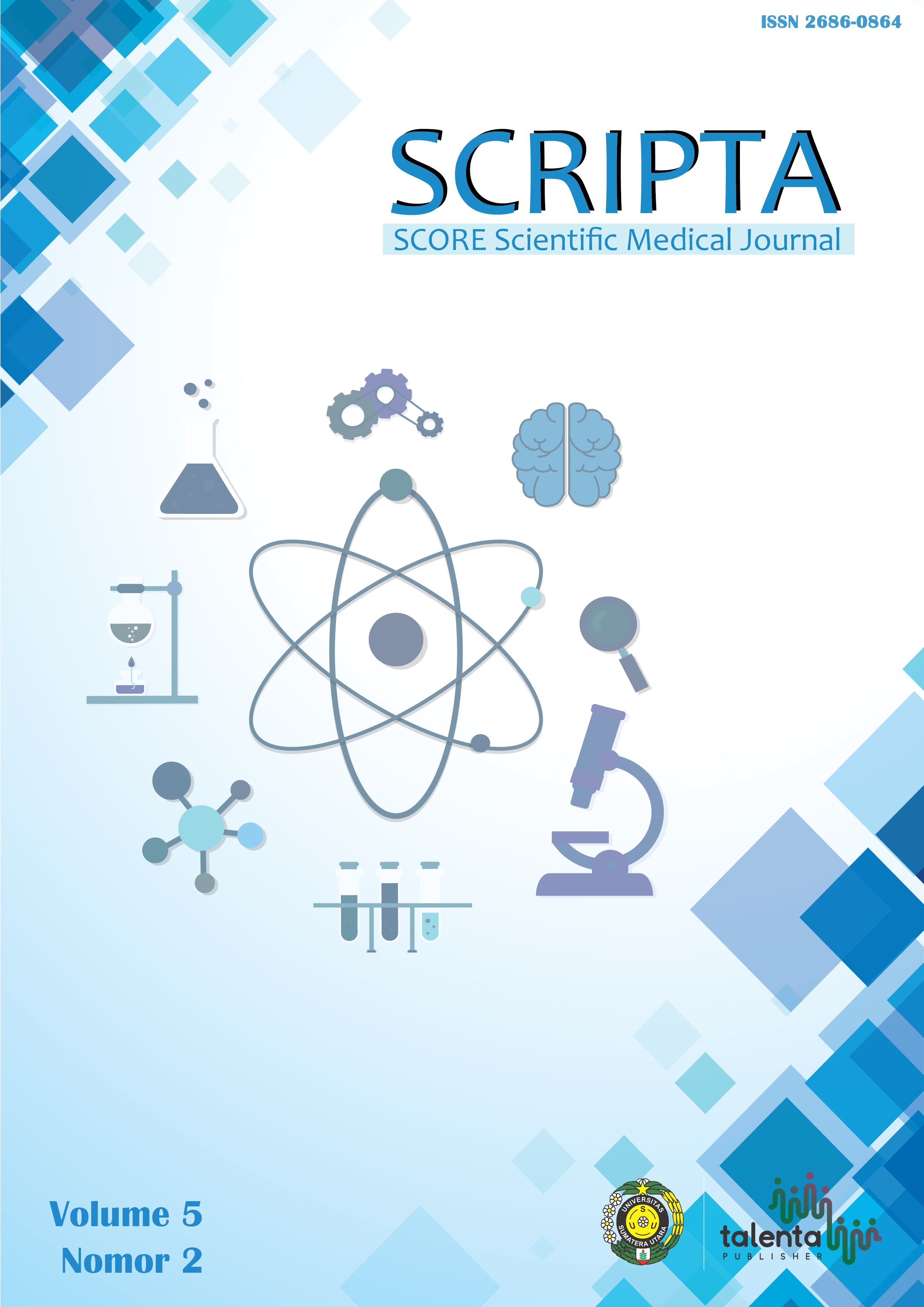Infeksi Oportunistik pada Orang dengan HIV/AIDS di RSUD Dr. Pirngadi Kota Medan Tahun 2018-2022
DOI:
https://doi.org/10.32734/scripta.v5i2.14902Keywords:
Candidiasis, CD4, Opportunistic Infection, PLWHA, Tuberculosis, Kandidiasis, Infeksi Oportunistik, ODHA, TuberkulosisAbstract
Background: The incidence of HIV/AIDS-related opportunistic infections should have decreased significantly in recent times due to antiretroviral therapy (ART). However, several factors such as patients diagnosed in the late stage of HIV infection, not starting and continuing ART, or ineffective ART will increase the incidence of opportunistic infections in PLWHA (people living with HIV/AIDS). Knowing about opportunistic infections in PLWHA can provide information about the types of opportunistic infections that occur most often and their epidemiology. Objectives: To identify opportunistic infections in PLWHA at RSUD Dr. Pirngadi Medan in 2018-2022. Methods: This study used analytical retrospective quantitative research using the Spearman correlation test by observing secondary data in the form of medical records with total sampling technique. Result: There were 253 PLWHA with opportunistic infections in 2018-2022 with the majority of male gender (82.6%), age group 25-32 years (37.5%), CD4 count <200 cells/mm3 (85.0%). The highest opportunistic infection was Tuberculosis (55.3%) followed by Candidiasis (45.8%). There was no correlation between CD4 count and Mycobacterium tuberculosis infection (p=0.620), but there was a correlation between CD4 count and Candida spp infection (p=0.013).Conclusion: There are differences in the types of opportunistic infections in PLWHA at RSUD Dr. Pirngadi Medan in 2018-2022.
Keyword: Candidiasis, CD4, Opportunistic Infection, PLWHA, Tuberculosis
Latar Belakang: Insiden infeksi oportunistik terkait HIV/AIDS seharusnya telah menurun secara signifikan di masa ini karena adanya terapi antiretroviral (ARV). Namun, beberapa faktor seperti penderita terdiagnosis pada stadium akhir infeksi HIV, tidak memulai dan melanjutkan terapi ARV, atau terapi ARV yang kurang efektif akan meningkatkan insiden infeksi oportunistik pada ODHA (orang dengan HIV/AIDS). Dengan mengetahui infeksi oportunistik pada ODHA dapat memberikan informasi mengenai jenis-jenis infeksi oportunistik yang paling sering terjadi dan epidemiologinya. Tujuan: Mengetahui infeksi oportunistik pada ODHA di RSUD Dr. Pirngadi Medan tahun 2018-2022. Metode: Penelitian ini menggunakan jenis penelitian retrospektif analitik bersifat kuantitatif menggunakan uji korelasi Spearman dengan cara mengobservasi data sekunder berupa rekam medik dengan teknik total sampling. Hasil: Didapatkan ODHA dengan infeksi oportunistik pada tahun 2018-2022 sebanyak 253 orang dengan mayoritas jenis kelamin laki-laki (82,6%), kelompok usia 25-32 tahun (37,5%), jumlah CD4 <200 sel/mm3 (85,0%). Infeksi oportunistik tertinggi adalah Tuberkulosis (55,3%) diikuti Kandidiasis (45,8%). Tidak terdapat hubungan antara jumlah CD4 dan infeksi Mycobacterium tuberculosis (p=0,620), tetapi terdapat hubungan antara jumlah CD4 dengan infeksi Candida spp (p=0,013). Kesimpulan: Terdapat perbedaan jenis infeksi oportunistik pada ODHA di RSUD Dr. Pirngadi Medan tahun 2018-2022.
Kata Kunci: CD4, Kandidiasis, Infeksi Oportunistik, ODHA, Tuberkulosis
Downloads
Downloads
Published
How to Cite
Issue
Section
License
Copyright (c) 2024 Ozora Joshua Porsea Manurung

This work is licensed under a Creative Commons Attribution-NonCommercial 4.0 International License.
Authors who publish with SCRIPTA SCORE Scientific Medical Journal agree to the following terms:
- Authors retain copyright and grant SCRIPTA SCORE Scientific Medical Journal right of first publication with the work simultaneously licensed under a Creative Commons Attribution-NonCommercial License that allows others to remix, adapt, build upon the work non-commercially with an acknowledgment of the work’s authorship and initial publication in SCRIPTA SCORE Scientific Medical Journal.
- Authors are permitted to copy and redistribute the journal's published version of the work non-commercially (e.g., post it to an institutional repository or publish it in a book), with an acknowledgment of its initial publication in SCRIPTA SCORE Scientific Medical Journal.














